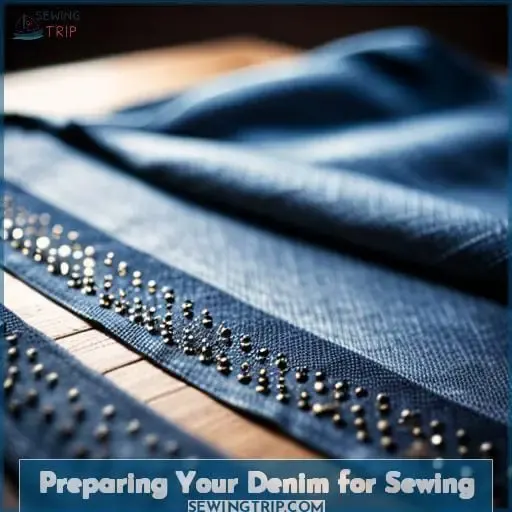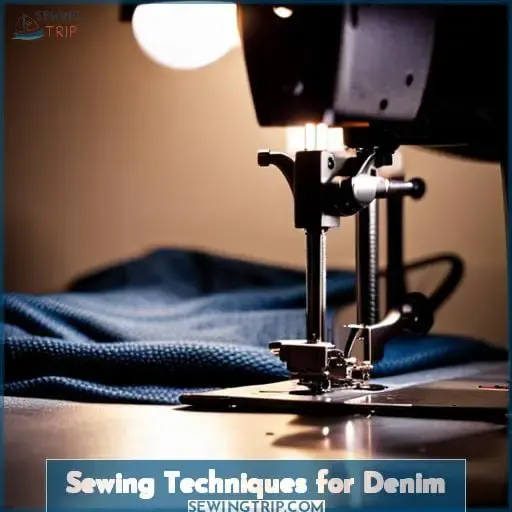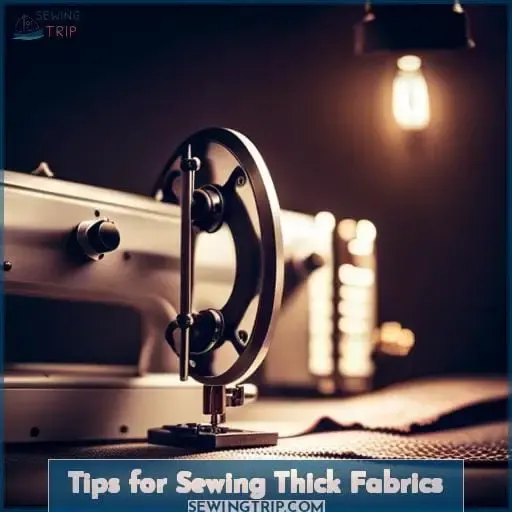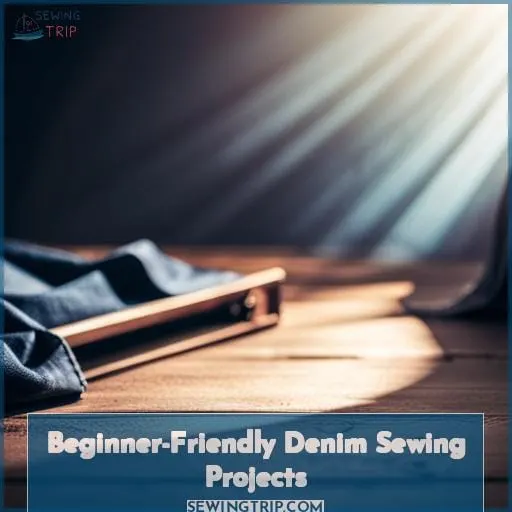This site is supported by our readers. We may earn a commission, at no cost to you, if you purchase through links.
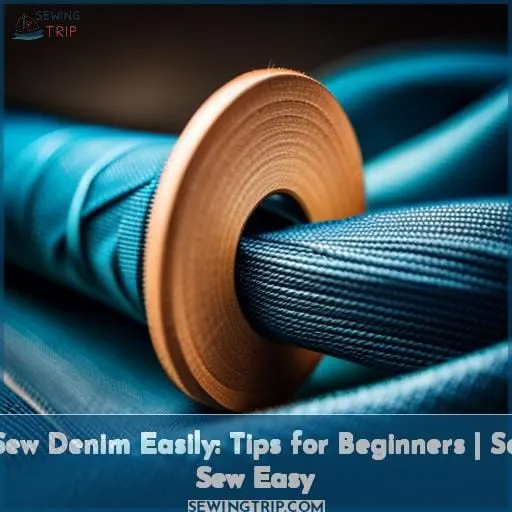
From choosing the right tools to troubleshooting common issues, we’ve got everything covered. Learn how to sew up your own jeans or other denim projects like jackets and skirts quickly and easily.
With our helpful hints on what type of thread or needles are best for thick fabrics, as well as some beginner-friendly project ideas, you’ll soon have sewn up something stylish that will last a lifetime!
Table Of Contents
Key Takeaways
- Choose sharp and strong needles, high-quality thread, and the right presser foot.
- Pre-treat denim by washing and drying to minimize shrinkage and dye running.
- Use proper cutting techniques for thick materials like denim.
- Employ different sewing techniques such as flat-felled seams for a stronger and professional finish.
Choosing the Right Tools
Choosing the right tools for sewing denim is essential to get good results. Needles should be sharp and strong, such as a size 90/14 for standard fabric or 100/16 for thicker denim; thread should be of high quality like Rasant thread; and pins must also be strong to hold up under pressure.
Needles
You’ll want to choose a strong needle, like an 80/12 universal, for chambray or tencel denim. For standard fabrics, use at least a size 90/14 needle, and for thicker denim, use a size 100/16 needle. Thread selection is key when tailoring – use high-quality thread like Rasant, made specifically for jeans.
Make sure your pins are sharp and strong to hold the fabric firmly without pushing or pulling it. Pre-treating tips, such as washing before sewing, can help avoid shrinkage issues later on. When dealing with thick materials like denim trousers, cutting techniques like layer by layer are essential.
Thread
Choose high-quality thread like Rasant to ensure your denim stays strong and long-lasting. Stitch length should be 2.8-3 for general sewing and 3.5-4 when topstitching. Protective fabric can provide a level surface when hammer tapping seams or bumpers can be used over bulky areas.
The black button on the machine foot helps eliminate skipped stitches. It is best to avoid using topstitching thread as it tends to fray easily. However, if you must use it, choose one that is strong enough not to snap under pressure! Take your time and go slow for best results.
Pins
Strong pins are essential for sewing denim, so make sure you have plenty on hand. For the best pinning technique, use sharp tools and avoid pushing or pulling the fabric. Thread choices should be of high quality to strengthen seams and protect against fraying.
Consider using a jeans presser foot when stitching over bulky areas or adding decorative touches like topstitching; it will help your garment look professional while providing extra fabric protection! Take time to master these techniques for an immaculate finish every time.
Preparing Your Denim for Sewing
Before you begin a sewing project with denim, it’s important to properly prepare the fabric. Pretreating your denim by washing and drying can help minimize future shrinkage and dye running off of the fabric.
Cutting out your pattern pieces carefully will ensure accuracy in size. Marking pieces such as pockets or darts should be done using tailor’s chalk or an air-soluble pen for easy removal later on.
Interfacing may also be used in areas such as collars to add extra structure if desired.
Pretreating
Before starting any project, it’s important to pre-treat your denim by washing and drying it for a softer fabric that will produce better results. To ensure quality work: 1) Pre-wash the fabric 2) Choose high-quality thread 3) Try different seam finishes 4) Use protective fabrics underfoot when hammer tapping 5) Hammer lightly when pressing seams.
Achieving professional-looking outfits requires attention to detail – from choosing the right tools, through pre-treating and careful stitching techniques.
Cutting
When cutting your denim, use sharp tools and strong pins to ensure precise results. To minimize bulk in the seams, lay out the fabric carefully before making any cuts. Choose a thread that’s strong enough for your project and adjust patterns if needed.
Fabric prep is essential – pre-washing will soften fibers while protecting from shrinkage or dye running when washed later on.
Marking
Marking denim requires careful placement of pins and marks so that you can create the perfect fit.
- Fabric preparation to soften fibers and prevent shrinkage.
- Seam pressing for a neat finish.
- Thread choices – use strong, quality thread for your project.
- Needle types – choose the right needle size depending on fabric weight (denim or thicker fabrics).
- Marking techniques – use sharp tools, strong pins, chalk pencils, or tailor’s tacks. With proper technique, you’ll have professional results every time! By following these steps, you’ll be able to sew with confidence, knowing that your finished garment looks great!
Interfacing
Interfacing is an important step when sewing denim. Use heavy-duty interfacing for extra reinforcement to ensure a strong garment that stands the test of time. Selecting the right pattern and fabric preparation is key, as well as selecting appropriate stitching options and seam allowances.
Sewing Techniques for Denim
When it comes to sewing with denim, there are some specific techniques that should be used in order to achieve the best results. Seam finishes, hems, and pressing all play a role in creating garments from this durable fabric.
Different types of seam finishes can help reduce fraying and make your seams stronger; hemming options include topstitching or using bias tape for extra strength; pressing is essential so that the seams remain flat and bulk-free.
Seam Finish
You’ll need sharp tools, heavy-duty needles, and jeans thread for strong and long-lasting seams when working with denim. Flat-felled seams are up to five times stronger than regular sewing! Thread types depend on the fabric weight – use Rasant for a standard machine or topstitching thread if desired.
Needle sizes vary from 80/12 universal needle for chambray or tencel denim to 90/14 size needle for standard fabric or 100/16 size needle for thicker fabrics.
Hem
When hemming denim, use strong pins to mark the desired length and press it flat for a professional finish. Choose needle types that match the fabric weight – an 80/12 universal needle works well with chambray or tencel denim, while thick fabrics require 90/14 size needles.
Pressing
To achieve a professional finish, press your denim seams flat and minimize bulk. Use fabric bumpers to level the foot when sewing over bulky seams, and consider adding hammer tapping for thick fabrics.
For regular stitching, use a 2.2 stitch length; increase it to 3-4 for topstitching! Hand turns on the machine may be necessary in tricky spots – just remember not to hit too hard or too often as this can split fibers! Finally, don’t forget the mysterious black button on your sewing machine foot that helps prevent skipped stitches.
Tips for Sewing Thick Fabrics
When it comes to sewing thick fabrics such as denim, a jeans presser foot or walking foot can help make the job easier. Additionally, using zigzag stitching can also help prevent fraying of the fabric.
Finally, flat-felled seams will give your garment a professional store-bought look and are stronger than regular seams.
Using a Jeans Presser Foot or Walking Foot
For a professional finish on your denim projects, try using a jeans presser foot or walking foot to secure the fabric and create flat seams. This will help prevent stretching of the denim and ensure that sewing tensions remain consistent.
It also allows you to make more durable seams, which are essential for any project involving thicker fabrics like denim. When selecting fabric, be sure to consider thread choice as well as needle size; sharp tools and heavy-duty needles work best with this type of material.
Using Zig-Zag Stitching
Zig-zag stitching is a great way to add extra strength and durability to your denim projects, as well as preventing fraying. To ensure the best results, carefully select the thread and needle size based on fabric selection.
Using Flat-Felled Seams
For a professional finish, try using flat-felled seams on your denim projects – they’ll give you a store-bought look and extra strength to boot! Not only do these seams provide fray prevention, but the stitch length and needle size should be carefully selected for the best results.
To ensure success with thick fabrics like denim, use a fabric bumper beneath the presser foot when sewing over bulky areas.
Get ready to show off your gorgeous jeans creations with confidence!
Troubleshooting Common Issues
When it comes to sewing denim, there are a few common issues that can arise. Skipped stitches, broken needles, and seam puckering can all be troublesome during the process. To ensure your project is successful, it’s important to take steps such as using the right type of needle and thread for your fabric weight, as well as taking time when stitching through thick fabrics like denim.
Skipped Stitches
Avoid skipped stitches when sewing denim by using a protective fabric bumper under the foot and tapping seams with a small hammer. Ensure proper thread tension, opt for larger needle sizes such as 90/14 for standard fabrics and 100/16 for thicker denim, use appropriate needles like denim needles to accommodate fabric thickness.
To prevent skipped stitches, also consider adjusting stitch length to 2.8-3 for general sewing or 3.
Breaking Needles
To prevent breaking needles while sewing denim, use sharp tools and heavy-duty needles that are designed to withstand the fabric’s rigidity. Pre-tensioning them prior to wear testing is also essential for ensuring they won’t break mid-seam.
Needle sizing should be appropriate for the thickness of your denim. A size 90/14 needle works well with standard fabrics, and 100/16 or higher will work better on thicker denims.
To ensure durability, consider stretching out your fabric before stitching. This helps reduce strain on the needle as it passes through multiple layers of material!
Finally, wear-proofing can be done by using a slightly larger zigzag stitch when topstitching seams. This provides extra strength in case of any accidental tugging or pulling during regular use.
Seam Puckering
Minimizing seam puckering requires strong pins, quality thread, and firm fabric holding to avoid pushing or pulling. Increase pressure and adjust thread tension for heavier fabrics. Pinning strategies should be tailored to the type of material you are working with; use wider stitch widths on lightweight fabrics and shorter stitches on thick denim materials.
Ensure your needles are appropriate for the weight of your fabric: a size 90/14 needle works well with standard fabrics while 100/16 is better suited for thicker denims.
Choosing the Right Denim for Your Project
If you’re planning a denim project, it’s important to consider the weight and thickness of the fabric, as well as whether or not it has stretch. The type of denim can also influence your color and wash choices. To ensure that your garment is comfortable, stylish, long-lasting, and fits correctly – choose wisely! Picking out the right kind of denim for your project requires some research into the different types available on the market today.
Weight and Thickness
You need to be mindful of the weight and thickness of your denim when selecting fabric for a project. Heavier fabrics may require extra care in order to sew them properly, while lighter ones can be sewn with ease.
Pay attention to stiffness, fading potential, layering capabilities, and resistance against abrasions.
Pre-washing is essential as it helps reduce shrinkage and soften the fabric prior to sewing. Be sure your thread is strong enough for all layers involved; this will help you achieve better results! Don’t forget that sharp tools like needles are necessary too – use long stitches on thicker fabrics or opt for zigzag stitching if fraying occurs.
Finally, remember that patience pays off. Take time when working through thick seams or bulky areas so they turn out perfect!
Stretch Vs. Non-Stretch Denim
When deciding which denim to use for your project, you’ll need to consider whether stretch or non-stretch is the best option – both have their benefits and drawbacks.
Consider:
- Stretch properties – a bit of give gives more comfort and movement.
- Non-stretch fabrics – great durability but can be restrictive.
- Fabric types – weight, thickness, and stiffness all affect the outcome!
- Denim textures – think about how it will feel on the skin and wear over time.
- Denim wash – faded look? Washed down? Brighter shades require extra care when washing/drying to keep the color vibrant and prevent fading!
Keep these factors in mind when selecting the right type of denim for your project so that it looks perfect every time you put it on!
Color and Wash
Choosing the right wash and color of denim for your project will help you make a fashion statement that stands out! Consider bleaching techniques, dyeing methods, stretch vs.
Stretch denim offers comfort while non-stretch provides great durability; pick what best suits your needs while keeping an eye on color selection amongst other factors like weight and stiffness.
Beginner-Friendly Denim Sewing Projects
As a beginner sewist, you may be wondering what denim project to tackle. There are plenty of projects available! From the simple Leonora bag, which uses just two pieces of fabric and is perfect for carrying essentials on-the-go, to Weston’s stylish take on the classic jean jacket that will add a unique touch to any wardrobe.
If you’re looking for something more advanced, Adelaide’s patterned jeans tutorial could be your next challenge as it involves creating intricate design elements. No matter what level sewer you are, there is sure to be an ideal denim sewing project waiting for you.
Leonora (Project Idea)
Bring a classic twist to your wardrobe with Leonora, the perfect denim dress that will have heads turning!
With styling options ranging from A-line skirts and fitted bodices to bell sleeves and pleats, there’s something for everyone.
When it comes to fabric selection, opt for hardwearing denim in medium or heavy weights.
To ensure a perfect fit, consider pattern selection carefully and don’t forget construction tips like using quality thread and sharp needles when sewing thick seams.
Finally, make sure you use the right tools for hemming, such as jeans presser feet and walking feet!
Weston (Project Idea)
Express your fashion-forward style with Weston, the perfect denim jacket that will leave everyone in awe! Choose hardwearing denim of medium to heavy weight for the best results. Pre-wash the fabric or opt for a distressed finish if desired. The needle size should be 90/14 or 100/16, depending on the thickness, and high-quality thread such as Rasant is essential when sewing thick seams.
Adelaide (Project Idea)
Take your wardrobe to the next level with Adelaide, a stylish denim skirt that will make you stand out from the crowd! Crafted using patchwork and dyeing techniques, this skirt features unique stitching details for an edgy look.
To ensure durability, put it through extensive tests before wearing. Choose fabric textures like twill or canvas for more structure or a distressed wash for a softer feel.
Frequently Asked Questions (FAQs)
How do I know which type of denim is best for my project?
Deciding which denim fabric is best for your project depends on the desired outcome.
What are the benefits of prewashing denim?
Prewashing denim softens it for more comfortable wear, minimizes shrinkage, and prevents dye from running. It also allows the fabric to be cut easier and eliminates any lumps from seams that could cause discomfort or an ill-fitting garment.
What is the best thread to use for sewing denim?
A strong, long-lasting thread is essential for sewing denim. Try Rasant thread for your machine – it will ensure the fabric holds up to wear and tear! For an extra sharp look, use a heavier topstitching thread and longer stitch length.
What are the best techniques to use when sewing thick fabrics?
When sewing thick fabrics, use sharp tools and strong needles. A jeans presser foot or walking foot can help keep the fabric in place. Opt for longer stitches when general sewing and topstitching with a quality thread like Rasant.
Hammer seams to avoid skipped stitches, but add a protective layer before doing so! Use the mysterious black button on your machine’s foot to level it over bulky areas.
How can I prevent fraying when sewing denim?
To prevent fraying when sewing denim, use zigzag stitching and flat-felled seams. Sharp tools, heavy-duty needles, and quality thread will ensure a strong seam. Pins should be strong to hold fabric firmly in place.
Conclusion
In conclusion, sewing denim can be a challenge, but with the right knowledge and tools, it can be a rewarding experience. Make sure to use the appropriate needles, thread, and pins to ensure your project lasts.
Additionally, use the correct techniques for seam finishing, hemming, and pressing to make your project look professional. Lastly, remember to choose the right denim for your project in terms of weight, stretch, and color.
How will you use denim to create your next project? With the right preparation and knowledge, you can create something beautiful and long-lasting.


